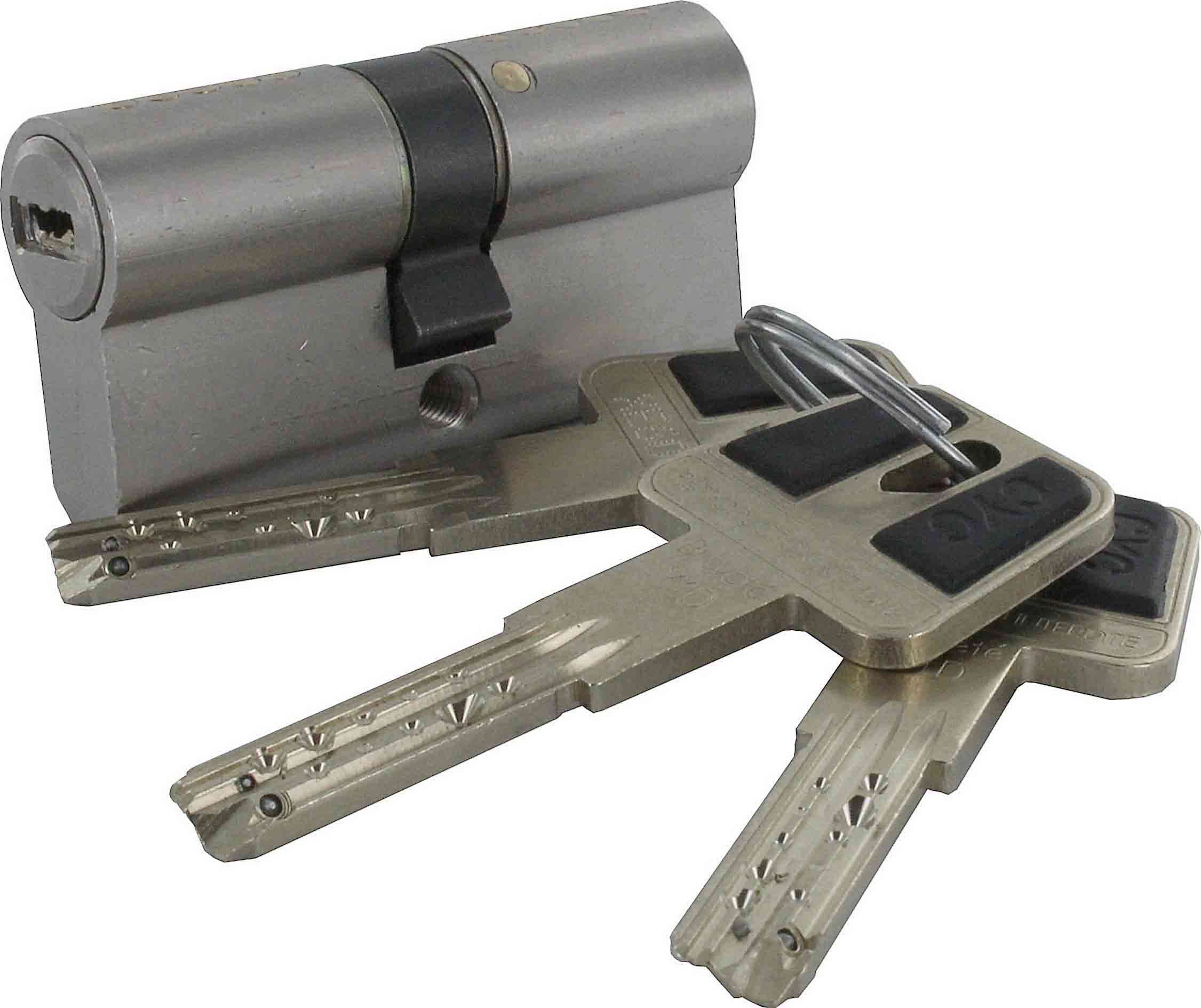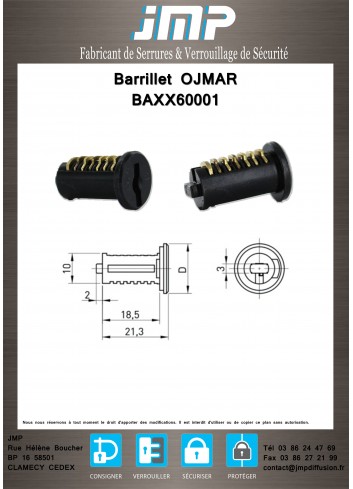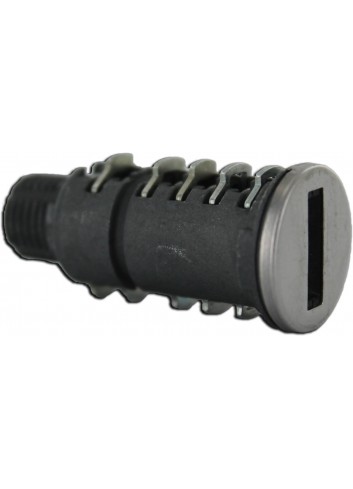- FAQ
- 0 likes
- 17424 views
- 0 comments

Barrel or Cylinder
Do you need a cylinder or a barrel? It is sometimes difficult to navigate the different terms used in the lock industry. This is why the JMP team is there to support you in your research.
In fact, a lock is made up of several very distinct parts such as a stator (body of the lock), a rotor (or barrel in which the key is inserted), spangles or pistons (which correspond to the notching of the key and allows you to define the security level of the lock) and of course the keys.
In this article we will take a detailed look at these barrel and cylinder terms, their similarities and differences in the language of the lock world, and how we define them at JMP.
Let's first introduce the different types of lock cylinders before getting to the heart of the matter.
LIST OF THE MAIN TYPES OF LOCK CYLINDER:
Double entry cylinder: To lock the door from inside or outside
Button cylinder: The door is locked or unlocked with a button, at the touch of a finger
Half cylinder: To close or open the door from one side only
Disengageable double entry cylinder: This allows the door to be opened or closed from the outside or from the inside even if the key is stuck in the lock, very practical if the door has been slammed.
Standard round cylinder: Allows the door to be opened from the outside only
European Shaped Impression Cylinder: Opens with a square, triangle or hexagonal socket wrench
If you want to secure your door or for any other locksmith issue, call a professional. JMP will advise you on the model of locking system best suited to your security requirements.
The barrel at JMP
 In locksmithing, the cylinder is the common name for the cylinder (technical), which by its use allows the locking or unlocking of a lock. There are different shapes and sizes of barrel, the best known is the European profile. There are different profiles for each brand of lock, namely rounds of different diameter, or tongue barrels, etc.
In locksmithing, the cylinder is the common name for the cylinder (technical), which by its use allows the locking or unlocking of a lock. There are different shapes and sizes of barrel, the best known is the European profile. There are different profiles for each brand of lock, namely rounds of different diameter, or tongue barrels, etc.
Half-opening barrels are a combination of different barrels which can be opened by the same key and open between them.
At JMP, the term lock cylinder or lock cylinder refers to the rotor, a part that is found in the stator (or body) for both cylinders and other types of lock type cam lock or mechanical code lock.
Examples of cylinder applications for different lock models:
Creation of tailor-made barrels at JMP:
JMP also offers you its expertise in the field of locks and security interlocking through know-how in foundry of various materials, ranging from bronze to stainless steel. This allows us to make your requests as unique as it is.
Our foundry allows us to reproduce parts that you could no longer find in a traditional distribution channel. Good to know, even a partially damaged part can be reproduced if we have the necessary data.
In direct connection with our 3D Printing division, we can also reproduce parts that you have in SolidWorks software (eg: .SDLPRT).
We support your various projects, do not hesitate to contact us for more information on our foundry sector.
Discover our possibilities in foundry for barrels, handles, complete locks or other types of parts.
1) THE ROTOR IN DETAIL:
The rotor of a lock barrel or barrel is the cylindrical mobile part in which the key is inserted. It is in the Rotor that the pins and counter pins or spangles are aligned. When the right key is inserted into the rotor, the pins or spangles align and by operating the key, it activates the bit or the cam.
Locking a cylinder lock is the process of aligning the pins without the key. Thanks to a percussion key which creates a vacuum between the pins and the counter-pins. This makes it easy to open cylinders with paracentric keys and some cylinders with higher security. A percussion key is a key made from a 999 key, ie with the holes at their maximum depth. To avoid picking, industrial locksmiths can include lures or false pins.
2) ANTI-DRILL BARREL:
Drilling the cylinder is also a technique frequently used to go through a lock and break it in seconds. Only door barrels with an anti-drilling safety device can withstand this method for a longer or shorter period. Absolutely avoid cylinders which will be pierced too easily ... A reinforced pad and pins adapted to the heart of the cylinder make it possible to slow down the drilling. The goal is to deter burglars who will not spend more than 3 minutes trying to drill your lock (For information, just on the visible face of your cylinder from the outside, a burglar will generally understand very quickly what is wrong with it. Very easy for him to know if he is in front of an unsecured entry-level lock or in front of a "reinforced" version of reference brands like Abus or Vachette for example).
Here again, the more your cylinder will be reinforced for anti-drilling prevention, the more difficult it will be to drill it. The most upscale models will be able to withstand more than 15 minutes because they are very often equipped with hardened steel rods.
3) ANTI-PULLING DOOR BARREL:
The anti-tear construction means the lock is made in 3 parts instead of being designed as a single block which can be more fragile. There is thus the outer part, the inner part and the third part consisting of the reinforcing bar on the lower part. These are 3 very distinct parts. Thus in the event of an attempt to extract, twist or tear off the cylinder will be much more resistant and almost impossible to break. If the latter breaks despite everything, it will do so before the center of the fixing screw, on the upper part of the cylinder and not right in the center as on a more standard model. Once broken in this position, the burglar will be forced to stop his manipulation but the door will not be opened. On a more standard door cylinder, when the lock breaks in its center, the burglar only has to drop the cylinder to open the door.
The cylinder at JMP
The lock cylinder, also called lock barrel or cylinder in general terms, is a very common system used to secure our doors.
The lock cylinder at JMP focuses only on our European cylinder models or A2P security locks. They can be mechanical or electronic.
1) HOW DOES A LOCK CYLINDER WORK?
 Operation side is simple: when you insert the key in the lock (cylinder), the cylinder actuates the bolt which in turn activates the strike. This action opens or closes the door.
Operation side is simple: when you insert the key in the lock (cylinder), the cylinder actuates the bolt which in turn activates the strike. This action opens or closes the door.
Inside, the lock cylinder consists of spring loaded pins and counter pins located on the stator (fixed part). A cylinder is made up of several pins, between 5 and 36. The more pins there are, the higher the safety system. A cylinder lock with 36 pins will be difficult for a burglar to pick up during a break-in.
To put it simply, the lock cylinder is the part in which the key is inserted. The cylinder consists of 2 elements:
- The stator: the fixed part of the lock cylinder also called the body
- The rotor: corresponding to a barrel, is the moving part receiving the key which turns on itself in a manual movement (which activates the key bit and which unlocks or locks the door).
On the budget side, the price of the lock cylinder varies between 50 euros and 200 euros depending on its complexity and the number of pins. The lock cylinder is sold with a set of keys.
It should be noted that the lock manufacturers aware of the inherent fragility of the compilation in the Rotor, modifications are made in order to make their locks very difficult to open with this technique (different springs, counter-pistons of different sizes, damper, false pins). Please note, this anti-bumping equipment is only present on very high security cylinders.
2) HOW TO CHOOSE YOUR LOCK CYLINDER:
Finding the right cylinder is not always easy ... There is a wide range of models and brands with many specificities. We offer to guide you through all our references by detailing the different characteristics of security lock barrels: Number of pins, rows of pins, patents, disengageable cylinder, cylinder opening, anti-picking, anti-drilling, anti - breakage, anti-tampering, number of keys, security index etc.
A cylinder, also a lock barrel or a lock cylinder, is decisive in stopping intrusion attempts.
3) THE DIFFERENT FEATURES IN DETAIL:
 To choose your lock cylinder you must first consider all the different specificities. This will allow you to understand the differences between the models and to guide your choice more wisely. Please note, it is very important to understand that all the characteristics do not have the same value depending on the model. Not all cylinders on our site are certified anti-picking. We must therefore focus on our A2P cylinder models.
To choose your lock cylinder you must first consider all the different specificities. This will allow you to understand the differences between the models and to guide your choice more wisely. Please note, it is very important to understand that all the characteristics do not have the same value depending on the model. Not all cylinders on our site are certified anti-picking. We must therefore focus on our A2P cylinder models.
To illustrate this, a level 1 anti-picking security cylinder will withstand a lock-picking attempt for between 2 and 5 minutes, while a heavily reinforced security model 3 will last for more than 15 minutes.
It's up to you to determine what you really need!
4) THE NUMBER OF BASIC KEYS AND ORDERING ADDITIONAL KEYS:
 There are different types: protected keys and unprotected keys. Flat keys and reversible keys are not protected and can be duplicated at a locksmith. Keys secured by patent or copyright can only be reproduced by the manufacturer, which guarantees a high level of security.
There are different types: protected keys and unprotected keys. Flat keys and reversible keys are not protected and can be duplicated at a locksmith. Keys secured by patent or copyright can only be reproduced by the manufacturer, which guarantees a high level of security.
The number of keys varies depending on the model and brand selected. Basically, it is generally 3 keys per cylinder but can fit up to 5 keys. It is of course possible to have additional keys made on all our security cylinders as soon as the order is placed. The price of the additional key is then more affordable because your entire order is made in one go especially for you with one or more additional keys. We manufacture a model for you with the required number of keys.
5) CYLINDER SAFETY INDEX:
The security index is calculated based on the characteristics of the product and the resistance time to various break-in attempts. The higher the index, the higher the resistance of your lock cylinder to attack. The security index of a lock cylinder is directly determined by the brands following numerous tests.
The aim of the Assurance Prévention Protection label is to identify products offering strong resistance to break-in attempts (forced openings: breaking, tearing, piercing; fine opening: picking, bumping).
It classifies them in 3 categories: 1, 2 or 3 stars.
A2P *: break-in resistance time = 5 minutes
A2P **: break-in resistance time = 10 minutes
A2P ***: break-in resistance time = 15 minutes
In order to preserve its A2P label, a lock must be associated with an A2P cylinder of the same brand and the same level. If a cylinder is certified, the A2P inscription must appear on it as well as on its key.
A2P certification is not compulsory and is the result of a voluntary process on the part of the manufacturer. This label is issued by an independent body, the CNPP (recognized by the state) and recognized by insurers.
6) THE PATENTS AND COPYRIGHT OF THE CYLINDERS:
The majority of "safety" cylinders or A2P cylinders currently on the market are patented until 2030 and those under copyright up to 99 years. It is therefore impossible for a locksmith to ensure reproductions of the keys, the latter having no knowledge of the technology used. Once the patent is complete, locksmiths will be able to make additional keys, but they will absolutely need your unique owner card number. A patent therefore protects you from unwanted reproductions.
JMP also offers connected lock cylinders for sale. Find more information on this page.
In conclusion, the cylinder is a part of the lock when the cylinder corresponds to a complete and ready-to-use lock. As the language in the lock engineering industry is complicated and professionals each use their own terms, we hope this article has helped you in your research to improve your security.
Please do not hesitate to contact JMP for more information.
Related products
- Out of Stock
- Out of Stock
- Out of Stock
- Out of Stock
- Out of Stock
- Out of Stock
- Out of Stock
- Out of Stock
- Out of Stock





















.jpg)



























Comments (0)